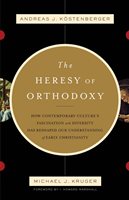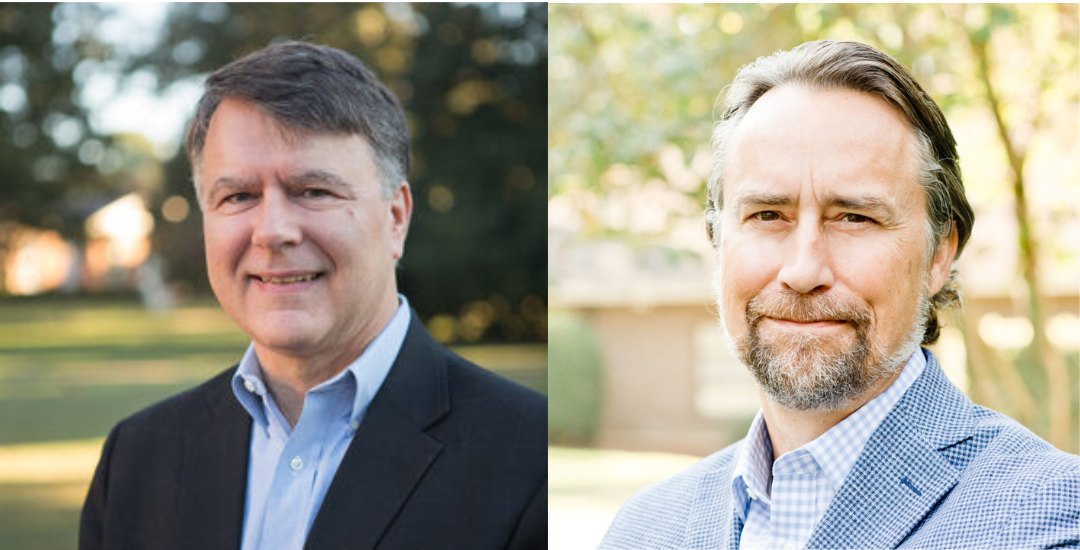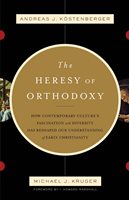You may not have heard the name Walter Bauer, but it is a bit more likely that you have heard the name of his 21st century popularizer, Bart Ehrman, who has made quite a name for himself by his attempts to dislodge Christianity at its very foundations. If you do not know these names, you should, especially if you are a pastor or church leader – if the Bauer-Ehrman attacks have not reached your congregation yet, it’s likely they will soon. And although God’s people trust Scripture instinctively, these questions are so radically serious that they will nag for answers.
Andreas Köstenberger (professor of New Testament at Southeaster Baptist Theological Seminary) and Michael Kruger (president and professor of New Testament at Reformed Theological Seminary, Charlotte) have teamed up to display the evidence, and their The Heresy of Orthodoxy: How Contemporary Culture’s Fascination with Diversity Has Reshaped Our Understanding of Early Christianity is a simple and clear demonstration of the sheer emptiness of every layer of the Bauer-Ehrman thesis. Their work easily makes its way to anyone’s short list of required reading on the subject, and it is a “must have” for every church library. Today Michael Kruger is with us to talk to us about their work.
 Fred Zaspel:
Fred Zaspel:
First, explain your title for us – The Heresy of Orthodoxy – and the thesis you are opposing. What is your book about?
Michael Kruger:
Our book is a response to Walter Bauer’s well-known book, Orthodoxy and Heresy in Earliest Christianity (originally published 1934), and his contemporary advocates like Bart Ehrman. Bauer argued that in the earliest stages of the Christian faith there was no such thing as “orthodoxy” (or “heresy” for that matter). Instead, there were various and contradictory versions of Christianity all claiming to be original and authentic. Our title is an intentional play off of Bauer’s title and is designed to communicate that the only “heresy” left in the modern academy is the claim that there is really something called orthodoxy in early Christianity.
Zaspel:
We’ll talk specifically about canon and text in a moment, but let’s begin with the alleged “original plurality of Christianities” idea. To be clear, in Bauer’s and Ehrman’s view, was there an “original” Christianity of any discernable sort? After all, it all had to begin somewhere. What about Jesus? And the apostles?
Kruger:
Bauer and Ehrman would certainly acknowledge that there was a historical Jesus and that he certainly taught something. The problem, they would argue, is that Christianity as a religion, as a system of thinking, was started by Jesus’ followers as they interpreted and applied Jesus’ teachings. And not all these followers agreed. They not only told different stories about what Jesus said and did, but they disagreed about what these events and words meant for the life of the church. Even when we look at the NT writings – the earliest Christian texts we have – they are a mix of contradictory doctrines and perspectives that demonstrate that lack of unanimity in the early faith (so the argument goes).

Zaspel:
Okay, this is known as “the Bauer thesis” that Ehrman has popularized. But Walter Bauer’s work was not entirely new, right? How was the way for his thesis paved by others before him?
Kruger:
No, Bauer’s thesis was not entirely new. The so-called “Quest for the Historical Jesus” had been happening for centuries, and many of the predecessors of Bauer had already begun to observe diversity within the early Christian faith, and within the NT writings in particular. For instance, F.C. Baur (1792-1860), head of the famous Tübingen school in Germany, had already argued that the NT documents revealed the various warring factions already at work in the first century. These sorts of arguments laid the foundation for what Bauer would later write (although he focused more on the second century and later).
Zaspel:
Let’s talk about the evidence, broadly speaking. There was a variety of views early on, but what can we legitimately deduce from this fact? Did heresy actually precede orthodoxy, or does Bauer’s work simply demonstrate early diversity? And if the latter, then we already knew that from each, Peter, Paul, and John, right?
Kruger:
We agree with Bauer and Ehrman that early Christianity was quite diverse, if by that we mean that there were disagreements and differences of opinion over a variety of matters. And, as you noted, we already know this just from the NT documents themselves which demonstrate that the earliest church faced a number of challenges from heretics, false teachers, and competing groups. The disagreement we have with Bauer/Ehrman is twofold: (1) we don’t think this diversity and disagreement was nearly as extensive as maintained. Bauer in particular was guilty of using the argument from silence to prove doctrinal diversity when none may have actually been there; and (2) we don’t think this diversity proves that there could not be an original version of the faith, or that the original version is unknowable. In our book, we argue that the characteristics of what we call “orthodox” Christianity appears to be the earliest version of the faith (according to our historical sources), and the most widely established version of Christianity within the early church.
Note: Please return tomorrow when we continue this interview with Dr. Kruger about their work, The Heresy of Orthodoxy.

